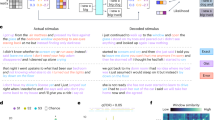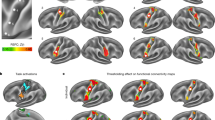Abstract
Pain is intimately linked with action systems that are involved in observational learning and imitation. Motor responses to one's own pain allow freezing or escape reactions and ultimately survival. Here we show that similar motor responses occur as a result of observation of painful events in others. We used transcranial magnetic stimulation to record changes in corticospinal motor representations of hand muscles of individuals observing needles penetrating hands or feet of a human model or noncorporeal objects. We found a reduction in amplitude of motor-evoked potentials that was specific to the muscle that subjects observed being pricked. This inhibition correlated with the observer's subjective rating of the sensory qualities of the pain attributed to the model and with sensory, but not emotional, state or trait empathy measures. The empathic inference about the sensory qualities of others' pain and their automatic embodiment in the observer's motor system may be crucial for the social learning of reactions to pain.
This is a preview of subscription content, access via your institution
Access options
Subscribe to this journal
Receive 12 print issues and online access
$209.00 per year
only $17.42 per issue
Buy this article
- Purchase on Springer Link
- Instant access to full article PDF
Prices may be subject to local taxes which are calculated during checkout






Similar content being viewed by others
References
Preston, S.D. & de Waal, F.B.M. Empathy: its ultimate and proximate bases. Behav. Brain Sci. 25, 1–71 (2002).
Decety, J. & Jackson, P.L. The functional architecture of human empathy. Behav. Cogn. Neurosci. Rev. 3, 71–100 (2004).
Gallese, V. The manifold nature of interpersonal relations: the quest for a common mechanism. Philos. Trans. R. Soc. Lond. B Biol. Sci. 358, 517–528 (2003).
Gallese, V., Fadiga, L., Fogassi, L. & Rizzolatti, G. Action recognition in the premotor cortex. Brain 119, 593–609 (1996).
Rizzolatti, G., Fogassi, L. & Gallese, V. Neurophysiological mechanisms underlying the understanding and imitation of action. Nat. Rev. Neurosci. 2, 661–670 (2001).
Fadiga, L., Fogassi, L., Pavesi, G. & Rizzolatti, G. Motor facilitation during action observation: a magnetic stimulation study. J. Neurophysiol. 73, 2608–2611 (1995).
Iacoboni, M. et al. Cortical mechanisms of human imitation. Science 286, 2526–2528 (1999).
Buccino, G. et al. Action observation activates premotor and parietal areas in a somatotopic manner: an fMRI study. Eur. J. Neurosci. 13, 400–404 (2001).
Leslie, K.R., Johnson-Frey, S.H. & Grafton, S.T. Functional imaging of face and hand imitation: towards a motor theory of empathy. Neuroimage 21, 601–607 (2004).
Keysers, C. et al. A touching sight: SII/PV activation during the observation and experience of touch. Neuron 42, 335–346 (2004).
Carr, L. et al. Neural mechanisms of empathy in humans: a relay from neural systems for imitation to limbic areas. Proc. Natl. Acad. Sci. USA 100, 5497–5502 (2003).
Wicker, B. et al. Both of us disgusted in My insula: the common neural basis of seeing and feeling disgust. Neuron 40, 655–664 (2003).
Flor, H. Phantom-limb pain: characteristics, causes, and treatment. Lancet Neurol. 1, 182–189 (2002).
Eisenberger, N.I., Lieberman, M.D. & Williams, K.D. Does rejection hurt? An fMRI study of social exclusion. Science 302, 290–292 (2003).
Rainville, P. Brain mechanisms of pain affect and pain modulation. Curr. Opin. Neurobiol. 12, 195–204 (2002).
Ingvar, M. Pain and functional imaging. Philos. Trans. R. Soc. Lond. B Biol. Sci. 354, 1347–1358 (1999).
Wittgenstein, L. Philosophical Investigations (Blackwell, Oxford, 1963).
Williams, A.C. Facial expression of pain: an evolutionary account. Behav. Brain Sci. 25, 439–488 (2002).
Hutchison, W.D. et al. Pain-related neurons in the human cingulate cortex. Nat. Neurosci. 2, 403–405 (1999).
Bradshaw, J.L. & Mattingley, J.B. Allodynia: a sensory analogue of motor mirror neurons in a hyperaesthetic patient reporting instantaneous discomfort to another's perceived sudden minor injury? J. Neurol. Neurosurg. Psychiatry 70, 135–136 (2001).
Singer, T. et al. Empathy for pain involves the affective but not sensory components of pain. Science 303, 1157–1162 (2004).
Jackson, P.L., Meltzoff, A.N. & Decety, J. How do we perceive the pain of others? A window into the neural processes involved in empathy. Neuroimage 24, 771–779 (2005).
Morrison, I., Lloyd, D., di Pellegrino, G. & Roberts, N. Vicarious responses to pain in anterior cingulate cortex: is empathy a multisensory issue? Cogn. Affect. Behav. Neurosci. 4, 270–278 (2004).
Wager, T.D. et al. Placebo-induced changes in FMRI in the anticipation and experience of pain. Science 303, 1162–1167 (2004).
Farina, S., Tinazzi, M., Le Pera, D. & Valeriani, M. Pain-related modulation of the human motor cortex. Neurol. Res. 25, 130–142 (2003).
Juottonen, K. et al. Altered central sensorimotor processing in patients with complex regional pain syndrome. Pain 98, 315–323 (2002).
Saitoh, Y., Shibata, M., Sanada, Y. & Mashimo, T. Motor cortex stimulation for phantom limb pain. Lancet 353, 212 (1999).
Farina, S. et al. Transient inhibition of the human motor cortex by capsaicin-induced pain. A study with transcranial magnetic stimulation. Neurosci. Lett. 314, 97–101 (2001).
Svensson, P., Miles, T.S., McKay, D. & Ridding, M.C. Suppression of motor evoked potentials in a hand muscle following prolonged painful stimulation. Eur. J. Pain 7, 55–62 (2003).
Urban, P.P. et al. Different short-term modulation of cortical motor output to distal and proximal upper-limb muscles during painful sensory nerve stimulation. Muscle Nerve 29, 663–669 (2004).
Maiani, G. & Sanavio, E. Semantics of pain in Italy: the Italian version of the McGill Pain Questionnaire. Pain 22, 399–405 (1985).
Melzack, R. The McGill Pain Questionnaire: major properties and scoring methods. Pain 1, 277–299 (1975).
Bonino, S., Lo Coco, A. & Tani, F. Empatia. I Processi di Condivisione delle Emozioni (Giunti, Florence, Italy, 1998).
Davis, M.H. Empathy: A Social Psychological Approach (Westview Press, Madison, Wisconsin, 1996).
Adolphs, R. Neural systems for recognizing emotion. Curr. Opin. Neurobiol. 12, 169–177 (2002).
Porro, C.A., Cettolo, V., Francescato, M.P. & Baraldi, P. Functional activity mapping of the mesial hemispheric wall during anticipation of pain. Neuroimage 19, 1738–1747 (2003).
Ploghaus, A., Becerra, L., Borras, C. & Borsook, D. Neural circuitry underlying pain modulation: expectation, hypnosis, placebo. Trends Cogn. Sci. 7, 197–200 (2003).
Meltzoff, A.N. & Decety, J. What imitation tells us about social cognition: a rapprochement between developmental psychology and cognitive neuroscience. Philos. Trans. R. Soc. Lond. B Biol. Sci. 358, 491–500 (2003).
Leibenluft, E., Gobbini, M.I., Harrison, T & Haxby, J.V. Mothers' neural activation in response to pictures of their children and other children. Biol. Psychiatry 56, 225–232 (2004).
Oldfield, R.C. The assessment and analysis of handedness: the Edinburgh inventory. Neuropsychologia 9, 97–113 (1971).
Wasserman, E.M. Risk and safety of repetitive transcranial magnetic stimulation: report and suggested guidelines from the International Workshop on the Safety of Repetitive Transcranial Magnetic Stimulation, June 5–7, 1996. Electroenceph. Clin. Neurophysiol. 108, 1–16 (1998).
Brasil-Neto, J.P. et al. Optimal focal transcranial magnetic activation of the human motor cortex: effects of coil orientation, shape of the induced current pulse, and stimulus intensity. J. Clin. Neurophysiol. 9, 132–136 (1992).
Mills, K.R., Boniface, S.J. & Schubert, M. Magnetic brain stimulation with a double coil: the importance of coil orientation. Electroencephalogr. Clin. Neurophysiol. 85, 17–21 (1992).
Rossini, P.M. et al. Non-invasive electrical and magnetic stimulation of the brain, spinal cord and roots: basic principles and procedures for routine clinical application. Report of an IFCN committee. Electroencephalogr. Clin. Neurophysiol. 91, 79–92 (1994).
Eisen, A. Electromyography in disorders of muscle tone. Can. J. Neurol. Sci. 14, 501–505 (1987).
Kimura, J. Electrodiagnosis in Diseases of Nerve and Muscle (F.A. Davis Company, Philadelphia, 1993).
Maeda, F., Kleiner-Fisman, G. & Pascual-Leone, A. Motor facilitation while observing hand actions: specificity of the effect and role of observer's orientation. J. Neurophysiol. 87, 1329–1335 (2002).
Gangitano, M., Mottaghy, F.M. & Pascual-Leone, A. Modulation of premotor mirror neuron activity during observation of unpredictable grasping movements. Eur. J. Neurosci. 20, 2193–2202 (2004).
Järveläinen, J., Schürmann, M. & Hari, R. Activation of the human primary motor cortex during observation of tool use. Neuroimage 23, 187–192 (2004).
Chen, R. et al. Depression of motor cortex excitability by low-frequency transcranial magnetic stimulation. Neurology 48, 1398–1403 (1997).
Acknowledgements
This research was supported by grants from the Ministero Istruzione Università e Ricerca and Finanziamento Italiano Ricerca di Base, Italy, both awarded to S.M.A.
Author information
Authors and Affiliations
Corresponding author
Ethics declarations
Competing interests
The authors declare no competing financial interests.
Supplementary information
Supplementary Fig. 1
Examples of raw MEP amplitudes for each observation condition in a representative subject of experiment 1. (JPG 34 kb)
Supplementary Fig. 2
Sensory and affective qualities of the pain supposedly felt by the model during observation of the different types of video clips in experiments 1, 2 and 3. (JPG 68 kb)
Supplementary Fig. 3
Self-oriented emotional reactions during observation of the different movies of experiment 1 measured by means of VAS. (JPG 81 kb)
Supplementary Fig. 4
MEP amplitude recorded from the FDI (black bars) and the ADM (white bars) muscles during the observation of 'Needle in FDI' condition of experiment 5 (expressed with respect to the correspondening static condition). (JPG 29 kb)
Supplementary Table 1
Mean amplitude (± s.e.m.) of F and M waves recorded from the FDI muscle in experiment 4. (JPG 32 kb)
Supplementary Table 2
Simple correlations between MEP amplitude changes recorded from FDI and ADM muscles and subjective ratings of 'Needle in FDI' video clips of experiment 1 and 5, and 'Needle in ADM' video clips of experiment 3. (PDF 44 kb)
Supplementary Video 1
Representative video clips showing the dynamic conditions of experiment 1: (i) a needle entering a right hand ('Needle in FDI'), (ii) a Q-Tip touching the right hand in regions overlapping those pricked by the needle ('Q-Tip on FDI') and (iii) a needle entering a tomato ('Non-Corporeal'). (MOV 2299 kb)
Rights and permissions
About this article
Cite this article
Avenanti, A., Bueti, D., Galati, G. et al. Transcranial magnetic stimulation highlights the sensorimotor side of empathy for pain. Nat Neurosci 8, 955–960 (2005). https://doi.org/10.1038/nn1481
Received:
Accepted:
Published:
Issue Date:
DOI: https://doi.org/10.1038/nn1481
This article is cited by
-
Temporal Unfolding of Racial Ingroup Bias in Neural Responses to Perceived Dynamic Pain in Others
Neuroscience Bulletin (2024)
-
The influence of agent’s gender on observer’s response in different action contexts
Current Psychology (2023)
-
Empathic pain observation does not influence automatic imitation in an online setting
Experimental Brain Research (2023)
-
The influence of EEG oscillations, heart rate variability changes, and personality on self-pain and empathy for pain under placebo analgesia
Scientific Reports (2022)
-
Can I Feel Your Pain? The Biological and Socio-Cognitive Factors Shaping People’s Empathy with Social Robots
International Journal of Social Robotics (2022)



